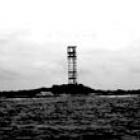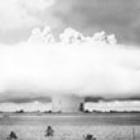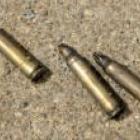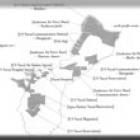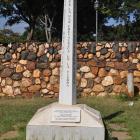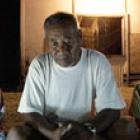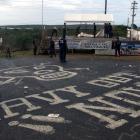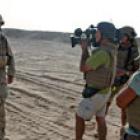Monuments
Monuments configure the way we interpret spaces by literally inscribing official military histories onto the landscape. They tell us which historical events (and which versions of those events) should count, whose deaths we should mourn, and what we should remember about a place. Thus, they indirectly tell us whose deaths don’t count and which histories of place should be forgotten or repressed. Because they cue observers to either celebrate or forget imperial violence, monuments have been pivotal sites for demilitarization struggles. Because they often frame battles and wars as historical events, monuments also obscure the ongoing environmental effects of war, which include toxic battlefields, weapons disposal sites, and pollution associated with military bases.

War in the Pacific National Historical Park
War in the Pacific National Historical Park
Photo by the US Department of the Interior, Office of Insular Affairs.
View source.
 This work is licensed under a Creative Commons Public Domain Mark 1.0 License.
This work is licensed under a Creative Commons Public Domain Mark 1.0 License.
Although it remains an unincorporated territory of the US, Guam’s government and landscape celebrate a colonial situation that has decimated indigenous Chamorro culture, language, and economic options. In the decades after the US acquired Guam in 1898, the US imposed a militarized, colonial spatial order on the island. After acquiring native lands from over one thousand families through appropriation, purchase, and extortion, the naval administration replaced old settlements with new villages “laid out in grids with street names often commemorating the military” (Herman 2008, 640). New buildings and infrastructure appeared with colonial and military names: “schools named for Presidents Washington, Truman, Johnson and Kennedy” and the Glass Breakwater, “named after Henry Glass, who seized the island in 1898” (Herman 2008, 640). Although US naval authorities once prohibited the Chamorro language on school grounds and burned Chamorro-English dictionaries, the island’s government continues to celebrate 21 July 1944—the day it was retaken from Japan by the US—as “Liberation Day.” Although Iraq war soldiers from Guam and other Pacific islands have “the highest per capita killed-in-action rate of the United States” (Bevacqua 2010, 50), the island is filled with monuments that commemorate American military heroism as a liberating force: the War in the Pacific National Historical Park, the Asan Wall Memorial, and even a memorial to War Dogs (Herman 2008, 650). Instead of noting the environmental problems associated with US bases or Guam’s long history of colonization by Spain, Japan, and the US, the website for the War in the Pacific Park offers only a catalogue of war artifacts and landscape descriptions that read like a tourist brochure: “At War in the Pacific National Historical Park, the former battlefields, gun emplacements, trenches, and historic structures all serve as silent reminders of the bloody World War II battles that raged across the Pacific. The park is known for its historic resources, but the verdant jungles, sandy beaches, turquoise waters, and stunning coral reefs also beckon visitors and residents to enjoy Guam.” This idyllic description masks Guam’s brutal geographic conditions: because military bases, dump sites, and training grounds occupy two thirds of the island, Chamorros with few economic alternatives enlist in a military that disproportionately assigns them to the most dangerous posts. (For a more detailed discussion of the environmental harm associated with US colonization in Guam, see my discussion of Craig Santos Perez’s poetry.)
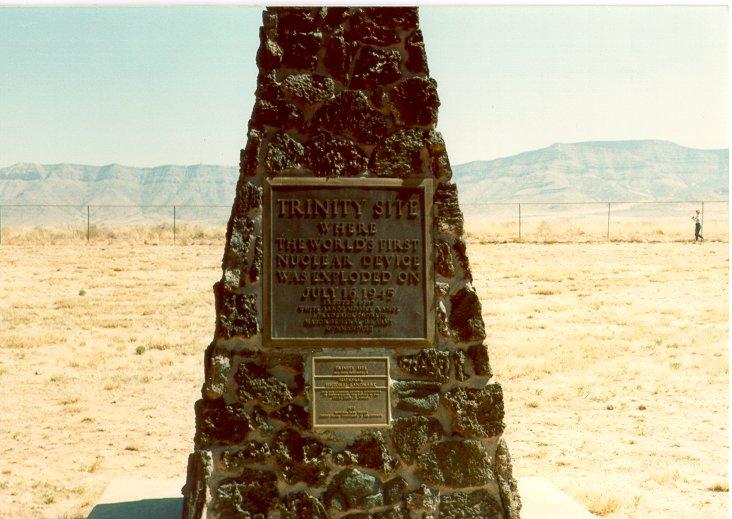
Trinity Site monument
Trinity Site monument
Photograph by Robert Skyhawk.
View source.
 This work is licensed under a Creative Commons Public Domain Mark 1.0 License.
This work is licensed under a Creative Commons Public Domain Mark 1.0 License.
In 1965, officials at the White Sands Missile Range erected a black lava rock obelisk to memorialize the site of the Trinity test. A plaque proclaims: “Where the World’s First Nuclear Device Was Exploded on July 16, 1945.” A second plaque added by the National Park Service in 1975 reads, “This site possesses national significance in commemorating the history of the U.S.A.” But, as Leslie Marmon Silko’s novel Ceremony reminds us, the site’s significance extends far beyond the nation’s boundaries. The novel’s protagonist, a Native American WWII veteran suffering from PTSD, eventually finds himself confronting the violent legacies of war at a uranium mine near the Trinity Site. Here, Tayo perceives a connection between Japanese and Native Americans caught up in a common pattern of nuclear destruction:
There was no end to it; it knew no boundaries; and he had arrived at the point of convergence where the fate of all living things, and even the earth, had been laid…. From that time on, human beings were one clan again, united by the fate the destroyers planned for all of them, for all living things; united by a circle of death that devoured people in cities twelve thousand miles away, victims who had never known these mesas, who had never seen the delicate colors of the rocks which boiled up their slaughter (246).
Providing another alternative perspective on the Trinity Site, James George’s novel Ocean Roads juxtaposes the life of an atomic scientist who witnessed the Trinity Test with the ordeals of younger people—including his own son—suffering from the effects of radiation poisoning.
Like these narrative engagements with the Trinity Site, the designation of Bikini Atoll as a UNESCO World Heritage Site in 2010 critiques the development of nuclear weapons. As UNESCO’s description of Bikini Atoll notes, “The many military remains bear witness to the beginnings of the Cold War, the race to develop weapons of mass destruction and a geopolitical balance based on terror. The violence exerted on the natural, geophysical and living elements by nuclear weapons illustrates the relationship which can develop between man and the environment. This is reflected in the ecosystems and the terrestrial, marine and underwater landscapes of Bikini Atoll.” Although Bikini Atoll is a World Heritage Site too poisoned to be safely visited, the irradiation of the island has nevertheless helped fuel a growing international anti-nuclear movement.
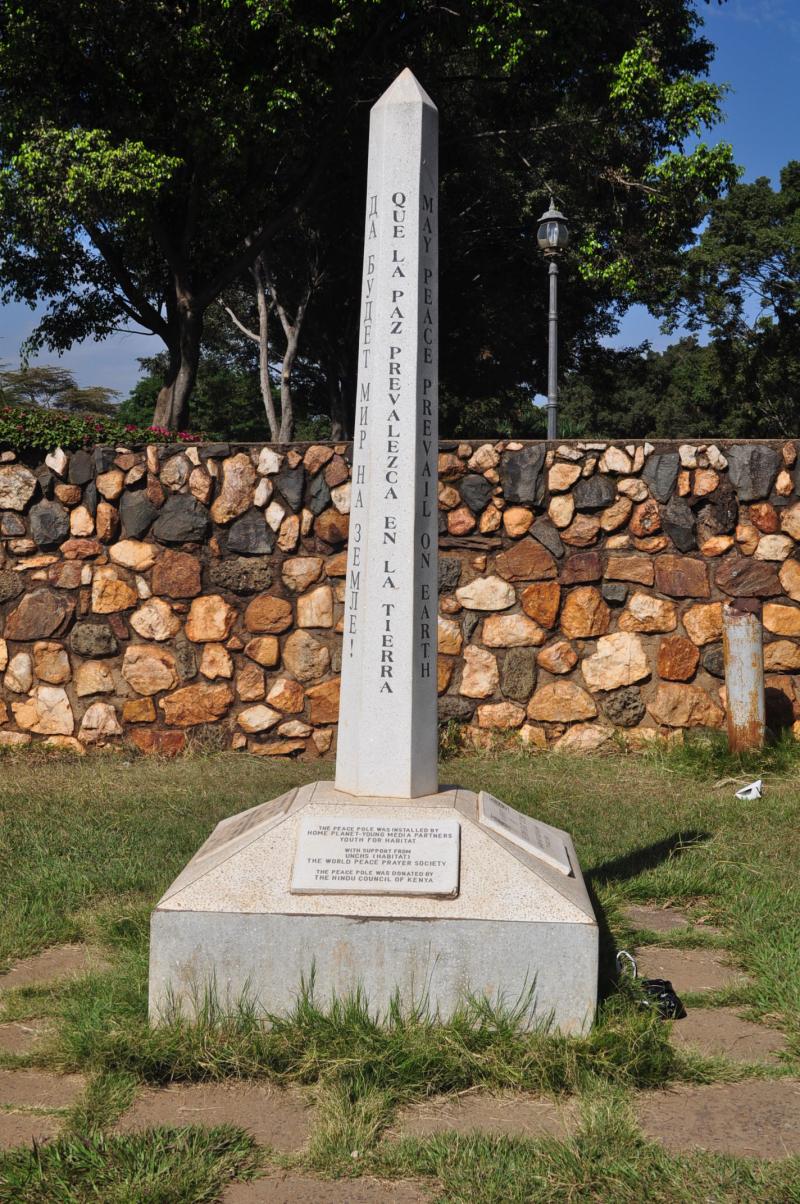
Peace pole erected in memory of the victims of the US embassy bombings in Nairobi and Dar es Salaam on August 7, 1998
Peace pole erected in memory of the victims of the US embassy bombings in Nairobi and Dar es Salaam on August 7, 1998
Photograph by Dennis Munene, 2012.
 This work is licensed under a Creative Commons Attribution-NonCommercial-ShareAlike 3.0 Unported License.
This work is licensed under a Creative Commons Attribution-NonCommercial-ShareAlike 3.0 Unported License.
Demilitarization activists have publicized the experiences of militarization’s victims by appropriating existing monuments. In November 2000, supporters of the movement to close the naval base in Vieques, Puerto Rico, hung the flags of Vieques and Puerto Rico along with a banner reading “Free Vieques” from the Statue of Liberty (eleven protestors were arrested at the action). By contrasting a colonial possession’s struggle to end dangerous bombing exercises with a monument to US independence, the activists highlighted not only the contradiction between freedom and empire but also the intimacy between US models of “freedom” and the nation’s constant readiness to engage in aggressive foreign wars.
Informal monuments provide another riposte to official monuments that glorify war and erase its harmful effects on civilians and the environment. Masahisa Goi, the Japanese spiritual leader and founder of the World Peace Prayer Society, introduced the tradition of the Peace Pole in 1976 in response to the violence of World War II and the devastation of atomic bombs. Peace Poles, as the society’s website explains, are simple obelisks whose four sides are inscribed with the prayer “May Peace Prevail on Earth” in different languages; they are either handmade or ordered from the international Peace Pole Project. To date, over 100,000 Peace Poles have been planted in at least 190 countries. Regarding the peace prayer itself, Goi, stated that “if you fling all of your thoughts into these simple words, and, from this prayer keep living your lives anew, before you know it your individualistic or cliquish feelings will diminish, and you will feel yourselves wishing for the happiness of mankind, with a feeling of humanitarian love welling up from within.” The utopian sensibilities that inform the peace pole provide a humanitarian and cosmopolitan alternative to the “cliquish” nationalism that underlies most war memorials.
Bibliography:
Bevacqua, Michael Lujan. “The Exceptional Life and Death of a Chamorro Soldier: Tracing the Militarization of Desire in Guam, USA.” In Militarized Currents: Toward a Decolonized Future in Asia and the Pacific, edited by Setsu Shigematsu and Keith L. Camacho, 33–62. Minneapolis: University of Minnesota Press, 2010.
George, James. Ocean Roads. Wellington: Huia Publishers, 2006.
Herman, R. D. K. “Inscribing Empire: Guam and the War in the Pacific National Historical Park.” Political Geography 27, no. 6 (2008): 630–51.
Loewen, James W. Lies Across America: What Our Historic Sites Get Wrong. New York: Simon and Schuster, 2007.
Silko, Leslie Marmon. Ceremony. New York: Viking, 1977.





